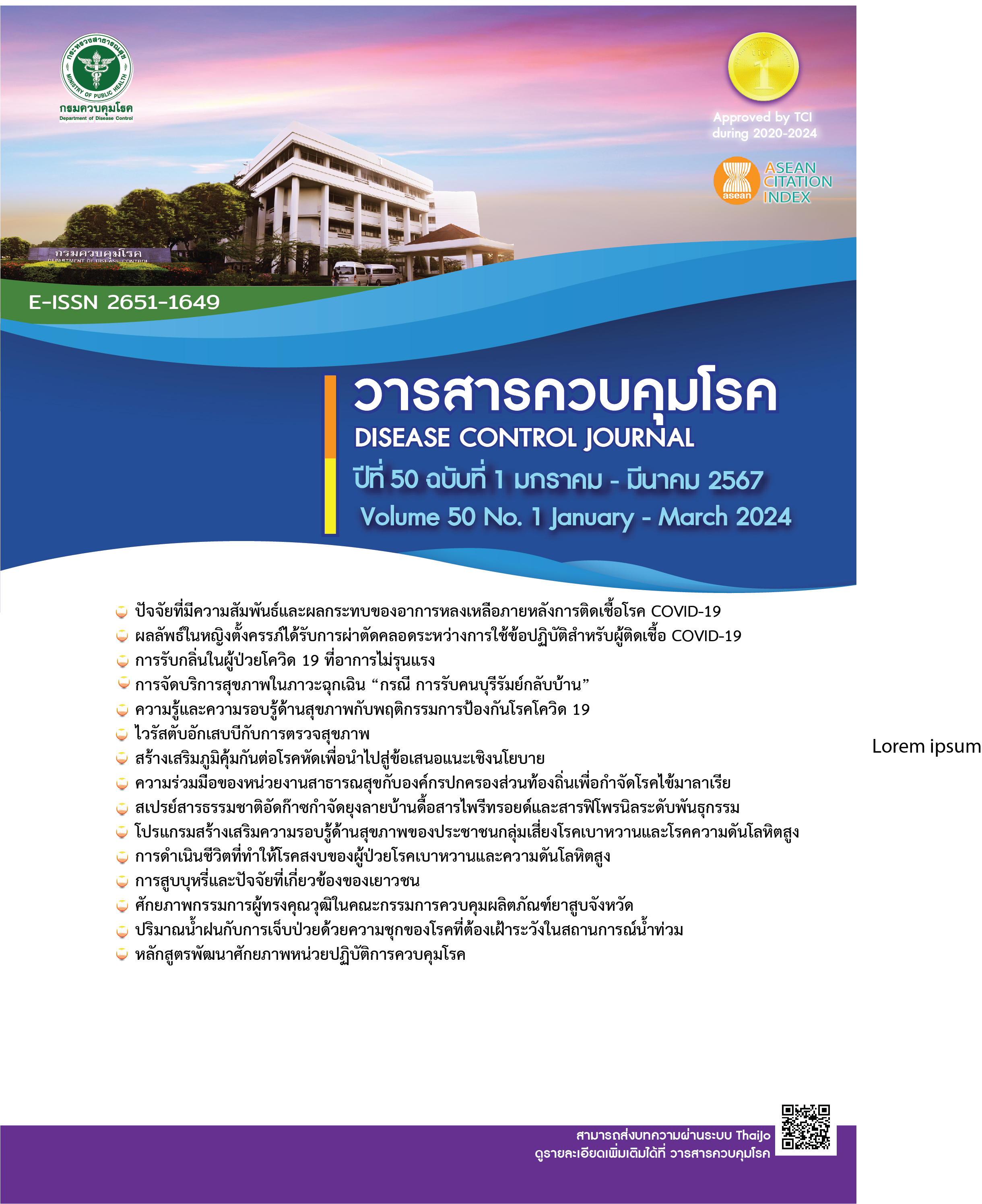Development of natural compound aerosol spray against genetic fipronil and pyrethroid-resistant Aedes aegypti mosquitoes in dengue risk areas in Thailand
DOI:
https://doi.org/10.14456/dcj.2024.9Keywords:
natural compound aerosol spray, genetic fipronil-and pyrethroid-resistant Ae. aegypti mosquitoes, gene mutation, para gene, Rdl geneAbstract
This research aimed to study a natural compound aerosol spray against genetic fipronil and pyrethroid-resistant Ae. aegypti mosquitoes in dengue risk areas in Thailand. A natural compound aerosol spray was developed that contained 5 natural compounds of citral, citronellal, citronellol, geraniol, and linalool at concentrations of 8.00%, 0.41%, 0.52%, 0.61%, and 0.75%, respectively as active ingredients. The aerosol spray was evaluated against fipronil and pyrethroid-resistant Ae. aegypti mosquitoes in glass chambers and Ae. aegypti mosquitoes in the fields of 6 provinces: Kanchanaburi, Chanthaburi, Chumphon, Phitsanulok, Nakhon Pathom, and Nakhon Ratchasima. Polymerase chain reaction (PCR) and DNA
sequencing were conducted to detect mutations in the para gene and the Rdl gene in Ae. aegypti mosquitoes that died in the fields. The result showed that the natural compound aerosol spray provided a 100% mortality rate for Ae. aegypti mosquitoes in both the glass chambers and the fields. Mutations in the para gene at amino acid positions of 989 (S989P) and 1016 (V1016G) were detected in the dead mosquitoes in the fields of 6 study provinces with mutation frequencies of 0.23-0.40 and 0.30-0.47, respectively. In addition, a mutation in the Rdl gene at an amino acid position of 302 (A302S) was found in dead mosquitoes in Kanchanaburi and Nakhon Pathom provinces with mutation frequencies of 0.13 and 0.20, respectively. In conclusion, the natural compound aerosol spray developed and tested in this study was effective against genetic fipronil and pyrethroid-resistant Ae. aegypti mosquitoes in dengue risk areas in Thailand. It suggests that the natural compound aerosol spray could be developed further as an alternative anti-mosquito product to anti-mosquito chemical products to prevent mosquito-borne diseases.
Downloads
References
Limkittikul K, Brett J, L'Azou M. Epidemiological trends of dengue disease in Thailand (2000-2011): A Systematic Literature Review. PLoS Negl Trop Dis. 2014;8(11):e3241.
Department of Disease Control (TH), Division of Epidemiology. DHF total [Internet]. [cited 2023 May 4]. Available from: http://doe.moph.go.th/surdata/506wk/y66/d262766_1766.pdf (in Thai)
Saavedra-Rodriguez K, Maloof FV, Campbell CL, Garcia-Rejon J, Lenhart A, Penilla P, et al. Parallel evolution of vgsc. mutations at domains IS6, IIS6 and IIIS6 in pyrethroid resistant Aedes aegypti from Mexico. Sci Rep. 2018;8(1):6747.
Muthusamy R, Shivakumar MS. Susceptibility status of Aedes aegypti (L.) (Diptera: Culicidae) to temephos from three districts of Tamil Nadu, India. J Vector Borne Dis. 2015;52:159-65.
Thompson M, Steichen JC, Ffrench-Constant, RH. Conservation of cyclodiene insecticide resistance-associated mutations in insects. Insect Mol Biol. 1993;2:149-54.
De Souza, L da Silva MJF, Macêdo LJ, Lacerda-Neto MAC, dos Santos HDM, Coutinho FAB, et al. Adulticide and repellent activity of essential oils against Aedes aegypti (Diptera: Culicidae)-A review. S Afr J Bot. 2019;124:160-5.
Chompoosri J, Khamsawads C, Tacharoenmuang R, Krutbut J, Makruen T, Rojanawiwat A, Efficacy of lemongrass aerosol sprays against insecticide-resistant Aedes aegypti mosquitoes from dengue risk areas. Dis Control J. 2022;48:83-98. (in Thai)
Chompoosri J, Khamsawads C, Krutbut J, Makruen T, Rojanawiwat A, Efficacy of natural compounds against genetically insecticide-resistant Aedes aegypti mosquitoes from dengue-risk areas in 6 provinces, Thailand. Beyond Resilience 2022 “Sustainable health development: Post Covid-19 pandemic crisis”; 2022 Sep 14-16; The 60th Anniversary of His Majesty the King’s Accession to the Throne International Convention Center, Prince of Songkla University, Songkla province; 2022. P. 98. (in Thai)
Sri-ard B. Preliminary research. 10th Ed. Bangkok: Suweriyasan Printing; 2017. (in Thai)
Chompoosri J, Tacharoenmuang R, Khamsawads C, Methawanitphong N, Krutbut J, Makruen T, et al. Insecticide susceptibility of genetically pyrethroid-resistant Aedes aegypti mosquitoes. Dis Control J. 2021;47:1303-18. (in Thai)
Tantely ML, Tortosa P, Alout H, Berticat C, Berthomieu A, Rutee A, et al. Insecticide resistance in Culex pipiens quinquefasciatus and Aedes albopictus mosquitoes from La Runion Island. Insect Biochem Mol Biol. 2010;40(4):317-24.
Abbott W. A method of computing the effectiveness of an insecticide. J Econ Entomol. 1925;18:265-7.
Sirsawat R, Komalamisra N, Apiwathnasorn C, Paeporn P, Roytrakul S, Rongsriyam Y, et al. Field-collected permethrin-resistant Aedes aegypti from central Thailand contain point mutations in the domain IIS6 of the sodium channel gene (kdr) Southeast Asian J. Trop. Med. Public Health. 2012;43(6):1380-6.
Srisawat R, Komalamisra N, Eshita Y, ZhengM, Ono K, Itoh TQ, et al. Point mutations in domain II of the voltage-gated sodium channel gene in deltamethrin-resistant Aedes aegypti (Diptera: Culicidae). Appl Entomol Zool. 2010;45:275-82.
Plernsub S, Saingamsook J, Yanola J, Lumjuan N, Tippawangkosol P, Sukontason K, et al. Additive effect of knockdown resistance mutations, S989P, V1016G and F1534C, in a heterozygous genotype conferring pyrethroid resistance in Aedes aegypti in Thailand. Parasit Vectors. 2016;9:417.
Zarrad K, Laarif A, Ben Hamouda A, Chaieb I, Mediouni-Ben Jemia J. Anticholinesterase potential of monoterpenoids on the whitefly bemisia tabaci and their kinetic studies. J Agr Sci Tech. 2017;19:643-52.
Georgiev B, Nikolova M, Aneva I, Dzhurmanski A, Sidjimova B, Berkov S. Plant products with acetylcholinesterase inhibitory activity for insect control. BioRisk. 2022;17:309-15.
Downloads
Published
How to Cite
Issue
Section
License
Copyright (c) 2024 Disease Control Journal

This work is licensed under a Creative Commons Attribution-NonCommercial-NoDerivatives 4.0 International License.
Articles published in the Disease Control Journal are considered as academic work, research or analysis of the personal opinion of the authors, not the opinion of the Thailand Department of Disease Control or editorial team. The authors must be responsible for their articles.






